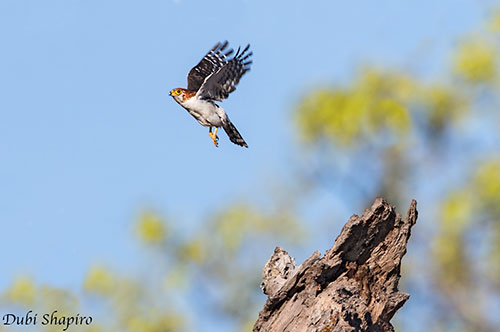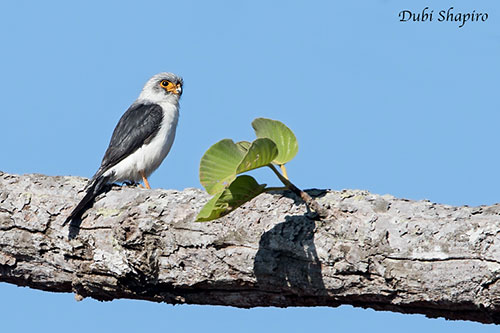
Fr: Fauconnet à pattes jaunes
Ang: White-rumped Falcon
All: Langschwanz-Zwergfalke
Esp: Halconcito Asiático
Ita: Falchetto groppabianca
Nd: Birmese Dwergvalk
Sd: orientalisk pygméfalk
Photographer:
Dubi Shapiro
Dubi Shapiro Photo Galleries & Dubi Shapiro's Pictures on IBC
Text by Nicole Bouglouan
Sources:
HANDBOOK OF THE BIRDS OF THE WORLD Vol 2 by Josep del Hoyo-Andrew Elliot-Jordi Sargatal - Lynx Edicions - ISBN: 8487334156
RAPTORS OF THE WORLD by James Ferguson-Lees et David Christie - Helm Identification Guides – ISBN: 0713680261
SORA - Breeding of the White-rumped Pygmy Falcon
THAI NATIONAL PARKS - White-rumped falcon
Global Raptor Information Network - Working to Conserve Birds of Prey in nature
Wikipedia, the free encyclopaedia
White-rumped Falcon
Polihierax insignis
Falconiformes Order – Falconidae Family
INTRODUCTION:
The White-rumped Falcon was described first in 1872 by Philip Sclater, secretary of the Zoological Society of London.
This species is more closely related to falcons of genus Falco than it is to pygmy falcons. It is native to Indochina.
The White-rumped Falcon frequents subtropical and tropical dry forests and wooded savannas of plains and foothills. It typically feeds on large insects, reptiles, amphibians, small birds and small mammals. It roosts and nests in tree holes.
The White-rumped Falcon is threatened by habitat loss through forest degradation and clearance. Hunting and persecution by humans are additional threats. The species is currently listed as Near Threatened.
The subspecies P.i. harmandi is displayed on this page.

DESCRIPTION OF THE BIRD:
Biometrics:
Length: 23-28 cm
Wingspan: 42-49 cm
Weight: 84-112 g
The White-rumped Falcon male of nominate race has greyish-white head and mantle with dusky streaks. Rump and uppertail-coverts are white. Upperwings and tail are slate-grey.
On the white underparts, sides of breast and flanks are streaked with grey. Flight-feathers and undertail feathers are spotted white.
On the head, cere, lores and broad eyering are yellow-orange. The bill is blackish. The eyes are dark brown. Legs and feet are yellow-orange.
The female has rufous head, nape and upper back. Rest of plumage and bare parts are similar to male. Forehead, eye area and cheeks are white and streaked dusky.
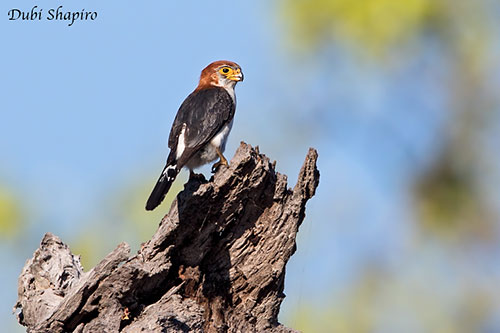
The male juvenile resembles adult male, but it has whitish collar and brown streaks on the underparts.
The female juvenile has rufous tinge to crown and nape, long before the streaking of the underparts disappears.
The juveniles have grey to yellowish cere and eyering.
SUBSPECIES AND RANGE:
The White-rumped Falcon has three subspecies.
P.i. insignis (described above) is found in W and C Myanmar (valley of R Irrawaddy).
P.i. cinereiceps occurs in S Myanmar (Tenasserim) and Thailand (except E).
This race is slightly darker grey above, involving more contrast between head and upperparts. It has plain underparts.
P.i. harmandi (displayed) is found in E and SE Thailand, C and S Laos, Cambodia and S Vietnam (S Annam – Cochinchina).
The male of this race has usually paler head with fine greyish shaft streaks.
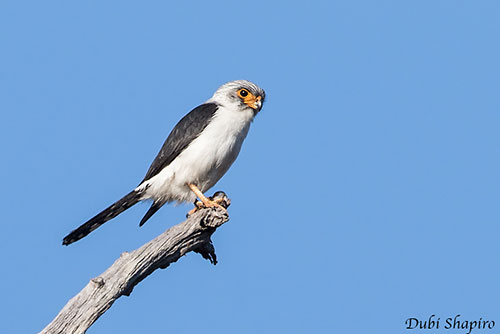
HABITAT:
The White-rumped Falcon frequents dry forests (dipterocarp) and mixed deciduous woodland. It can be seen at edges and in clearings, in wooded savannas and also in more open country. It is present from lowlands up to 900 metres of elevation, but it usually occurs below 700 metres.
CALLS AND SONGS: SOUNDS BY XENO-CANTO
The White-rumped Falcon produces a long, descending whistle. Both adults utter some sounds around the nest while the male is bringing food.
Near the nest, the male also gives a whistled phrase “wee-you-pity-you” sometimes repeated, and a harsh “sheer” in alarm or when excited. This call is often given while the male is hanging at the nest entrance.
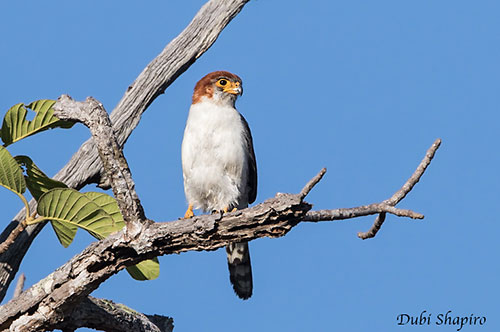
BEHAVIOUR IN THE WILD:
The White-rumped Falcon feeds on large insects such as cicadas, grasshoppers and beetles, amphibians, reptiles (lizards), small birds and small mammals.
It usually hunts from perches by sallies to catch birds or flying insects. Grasshoppers are caught on the ground, like lizards and small mammals.
From an observation, a nesting female was hunting several times on the ground, four times into foliage and some prey were caught on branches or twigs.
The White-rumped Falcon nests apparently in hole in tree such as abandoned woodpecker nest. Aerial displays are not reported, but mutual preening was observed between mates.
Some vocal displays can be hear around the nest, when the male brings food while giving a shrill flight call “chwirr chur chur”, only one or in series. The female responds with monotonous “cheep” calls also heard when she is alone at nest. This call is a soft purr when she is alone, becoming a harsh screech when she is perched close to the male bringing the food. The female may sometimes fly up to 200 metres from the nest to meet the male, in order to get the prey. Some other sounds can be heard near the nest (see “Calls and Songs” above).
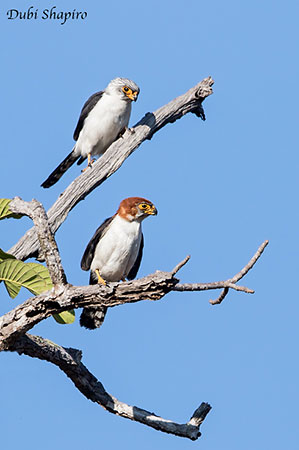
The White-rumped Falcon is apparently sedentary.
It flies fast with rapid wingbeats interspersed with long glides. While hunting in flight, it twists and turns with agility before gliding back to the perch.
REPRODUCTION OF THIS SPECIES:
The breeding season occurs between February and April. Eggs can be seen in March/April.
From an observation, the White-rumped Falcon nests in hole in tall tree Shorea obtusa (24 metres), among several large trees along the crest of a low ridge in dry deciduous dipterocarp forest.
The nest entrance was 12 metres above the ground, and two metres below the first branches. The cavity was lined with fine wood chips.
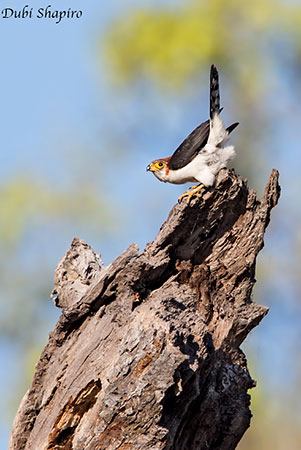
In early April, two white eggs were in the nest. The incubation was performed by the female, and the male entered the cavity when delivering food. It roosted inside the cavity with the female. The type of prey includes lizards, cicadas and other insects. The female was hunting only within 50 metres around the nest tree.
Both mates were calling near the nest while the male brought food to the female. Head bobbing by both mates was observed while examining the prey. The male was seen pumping its tail up and down several times while the wings were drooped, in order to display the white rump and the white-spotted tail. No more information.
PROTECTION / THREATS / STATUS:
The White-rumped Falcon is threatened by degradation and clearance of the forest for wood exploitation and by burning. This species is also affected by persecution and hunting in much of the range.
The population is placed in the band 15,000/30,000 individuals. The species is described as uncommon and local, and the numbers are probably declining.
The White-rumped Falcon is currently listed as Near Threatened.
